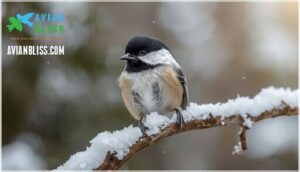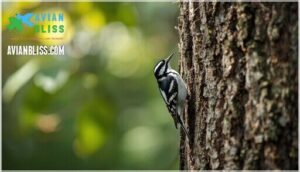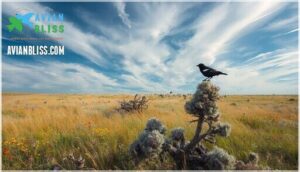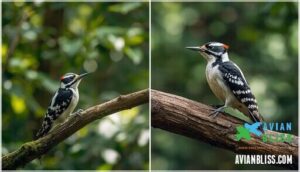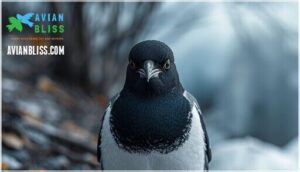This site is supported by our readers. We may earn a commission, at no cost to you, if you purchase through links.

Black and white plumage helps birds blend into shadows, signal their flock, and even confuse predators mid-flight. You’ll spot these striking patterns on over 100 species across North America alone, from tiny warblers creeping up tree trunks to massive seabirds diving 60 feet for fish.
Understanding what makes each species unique reveals how coloration shapes where they live, what they eat, and how they’ve adapted to thrive.
Table Of Contents
- Key Takeaways
- Types of Black and White Birds
- Habitats and Geographic Distribution
- Diet and Feeding Behaviors
- Unique Coloration and Adaptations
- Conservation and Ecological Importance
- Frequently Asked Questions (FAQs)
- What bird is black with a white belly?
- What is a small black bird with a white belly?
- What bird has a red head and yellow body?
- What is the name of a bird that is black and white?
- What is a black and white crow like bird?
- What is the black and white bird that looks like a penguin?
- What threats do black and white birds face?
- How do black and white birds reproduce?
- What are typical black and white bird calls?
- How do black and white birds migrate?
- Conclusion
Key Takeaways
- Black and white plumage serves three key survival functions—blending into shadows through countershading, enabling visual communication between flock members, and confusing predators during flight.
- North America has lost nearly 3 billion breeding birds since 1970, with grassland species declining 53%, while insectivorous black and white birds like warblers consume 400–500 million tons of insects yearly as natural pest controllers.
- Size, bill length, and vocal patterns distinguish similar-looking species—Downy Woodpeckers measure 6–7 inches with stubby bills and dropping calls, while Hairy Woodpeckers span 9–11 inches with head-length bills and steady calls.
- Black and white birds display extreme habitat diversity across every continent except Antarctica, from Emperor Penguins diving 500 meters in polar waters to Black-billed Magpies thriving in urban North American parks.
Types of Black and White Birds
Black and white birds come in all shapes and sizes, from tiny chickadees to large loons. Each species has unique markings that help you identify them in the field.
Let’s look at some of the most common black and white birds you’re likely to spot.
Common Loon Characteristics
The common loon draws the eye on northern lakes with its striking black-and-white checkered back and glossy black head. You’ll recognize breeding adults by their distinctive white "necklace" marking and piercing red eyes. These waterbirds measure 26 to 36 inches long, with dense bones that improve diving adaptations—they routinely plunge 13 to 33 feet deep hunting fish.
During migration patterns, loons shift to duller gray-brown winter plumage while maintaining white bellies year-round, making identification straightforward across seasons. They’re often found in boreal forest species, breeding in Canada and the northern United States.
Black-Capped Chickadee Features
While loons patrol deep waters, you’ll find the black-capped chickadee closer to home among backyard birds and mixed forests. This songbird shows a clean black cap and throat contrasting with bright white cheeks and a pale belly. You can’t miss the buffy sides that soften its stark plumage details. Black-capped Chickadees are increasingly found in spruce-fir mountain zones.
Identifying characteristics include:
- Vocalization analysis reveals up to 16 distinct calls, with alarm calls adding more "dee" notes as danger increases
- Morphometric data shows adults average 11.37 grams and 12–15 cm long, with minimal size differences between sexes
- Habitat adaptation spans Alaska through Canada into northern U.S. forests, urban yards, and mountain slopes
- Hybrid identification requires careful study—11% of Colorado birds show genetic mixing despite typical blackcapped chickadee appearance
Males and females look nearly identical, though juveniles display fluffier feathers and less defined bibs.
Black and White Warbler Identification
You won’t mistake the black-and-white warbler for any backyard visitor. This species creeps along tree bark like a nuthatch—a foraging style unique among warblers. Look for bold black-and-white striping covering the crown, back, and wings.
Adults measure 11–13 cm with a 21 cm wingspan. Males weigh slightly more than females, ranging from 8.8–15.2 grams. The white median crown stripe bordered by black lateral lines distinguishes breeding males from similar black and white bird species. Juveniles show reduced streaking and a mottled appearance. Habitat clues include mature deciduous or mixed forests, often near swamps or rocky woodlands from Canada to Texas. During migration, you’ll spot them on lower tree trunks across their range.
| Feature | Description |
|---|---|
| Plumage Variations | Males show darker face patches and throat; females display gray cheeks with buff-washed flanks |
| Distinguishing Features | Two white wing bars, white eyebrow stripe, slightly decurved bill adapted for bark foraging |
| Vocalizations | High-pitched, squeaky "weesy-weesy-weesy" song repeated during breeding season |
| Behavior Patterns | Vertical trunk foraging, short undulating flight, single-bird feeding movements |
Carolina Chickadee Description
You’ll recognize the Carolina Chickadee by its compact size and clean black-and-white head pattern. This bird species measures just 11.5–13 cm long and weighs 9–12 grams—small enough to dangle upside down while foraging. Here’s what sets this common backyard bird apart:
- Physical Dimensions: Wingspan spans 16–21 cm with a square-ended tail
- Plumage Details: Black cap and bib contrast with white cheeks and buff flanks; gray back lacks white wing patches
- Habitat Preference: Year-round resident in southeastern hardwood forests, swamps, and suburban yards
When identifying bird species, listen for the four-note "fee-bee fee-bay" call. Feeding habits shift seasonally—insects dominate spring menus, while seeds sustain them through winter. Vocal communication includes predator-specific alarm calls that vary by threat size.
Lark Bunting Habitat and Behavior
You’ll find Lark Buntings across shortgrass prairies and sagebrush plains from southern Alberta to northern New Mexico. During breeding season, males defend territories while both parents share nest duties—a cooperative approach that boosts fledging success.
These nomadic birds follow rainfall patterns, concentrating where grasslands stay green. Their diet shifts from insects in summer to seeds in winter.
Habitat loss has driven an 86% population decline since 1970, making conservation efforts critical for survival.
Downy and Hairy Woodpecker Comparison
At first glance, you might confuse these two forest bird species—but size differences and bill morphology give them away. Downy Woodpecker measures 6–7 inches with a short, stubby bill, while Hairy Woodpecker spans 9–11 inches with a bill as long as its head.
Both share habitat overlap in forests and parks, though Downy favors suburban areas and Hairy prefers mature woodlands.
Vocal distinctions help too: Downy’s call drops in pitch, Hairy’s stays steady. Diet variations are subtle—both eat insects, but Downy includes more plant material and forages on smaller branches. Woodpecker identification often hinges on these details.
Other Notable Species (Magpie, Penguin, Albatross, Oystercatcher)
Beyond woodpeckers, several striking black and white birds showcase diverse adaptations. Black-billed Magpies demonstrate considerable adaptability across urban and agricultural landscapes in western North America, with stable populations.
Emperor Penguins face severe decline—down 22% since 2009 due to sea-ice loss. Laysan Albatrosses migrate up to 120,000 km annually, following Southern Ocean wind corridors.
American Oystercatchers show notable site fidelity, with over 85% returning to the same nesting sites each breeding season along Atlantic coasts.
Habitats and Geographic Distribution
Black and white birds live in some of the most diverse places on Earth. You’ll find them in dense forests, open wetlands, rocky coastlines, and even bustling city streets.
Let’s look at where these striking species make their homes across the continent and around the world.
North American Black and White Birds
North America hosts 2,059 bird species, and black and white birds thrive across diverse habitats here.
You’ll spot Downy and Hairy Woodpeckers in forests, urban parks, and gardens where hardwood trees grow. Black-and-white warblers reach their highest breeding densities in Minnesota’s Boreal Hardwood Overlap Region.
Common Loons prefer large northern lakes for breeding before migrating to coastal waters. Lark Buntings nest in central grasslands and prairies, then fly south to Mexico for winter.
Global Species and Their Ranges
Black and white birds inhabit every continent except Antarctica’s interior, displaying striking habitat diversity and migration patterns. You can track these species across drastically different landscapes:
- Black-billed Magpies range across western North America in open woodlands and grasslands
- Black-bellied Plovers migrate over 10,000 kilometers from Arctic tundra to six continents’ coasts
- Wandering Albatrosses traverse the Southern Ocean with foraging trips reaching 10,000 km from breeding sites
- Eurasian Magpies occupy territories from Western Europe through eastern Asia in urban and rural settings
This geographic distribution reveals extreme population variability—some species exceed 815 million individuals, while others maintain fewer than 5,000.
Preferred Environments (Forests, Wetlands, Coasts, Urban Areas)
You’ll find habitat selection varies dramatically among black and white birds. Forest dependency runs strong in Black-and-white Warblers, Carolina Chickadees, and Downy Woodpeckers—they prefer mature deciduous and mixed forests with high canopy density.
Wetlands attract these species during migration, where wetland foraging becomes essential in riparian zones and swamps.
Coastal regions host Oystercatchers and Penguins on beaches and rocky shores.
Urban adaptation appears in 28% of surveyed species, with Magpies and chickadees thriving in parks through opportunistic coastal nesting and feeding strategies.
Diet and Feeding Behaviors
Black and white birds show a wide range of feeding habits that match their environments. Some species hunt insects in forests while others catch fish along coastlines.
You’ll find these birds fall into three main feeding groups based on what they eat and how they find food.
Insectivorous Black and White Birds
Among the most effective pest controllers in forests, insectivorous Black and White Birds like the Black-and-White Warbler rely on specialized foraging strategies to capture beetles, caterpillars, and ants. This warbler’s unique bill morphology allows it to pry insects from bark crevices, consuming over 90% insects during breeding season.
Their diet directly aids pest control and forest health. However, habitat loss has contributed to population decline, with numbers dropping 1-2% annually since the late 1990s despite their ecological importance.
Aquatic Foragers and Fish-Eaters
You’ll spot piscivorous black-and-white seabirds like penguins and cormorants mastering impressive diving adaptations. Emperor Penguins plunge beyond 500 meters, holding their breath for 20 minutes while hunting Antarctic silverfish. Great Cormorants use underwater hearing for prey selection, capturing smelts and wrasses during 30-second dives.
These coastal birds and waterfowl face habitat threats from overfishing and oil pollution, making conservation efforts critical for their survival.
Omnivorous and Generalist Feeders
Unlike those deep divers, generalist feeders like magpies and chickadees thrive on dietary flexibility. These black and white birds shift their food sources seasonally, tackling insects during breeding season and switching to seeds when winter hits.
Urban bird diets reveal impressive adaptability:
- Magpies mix 35–55% animal matter with plant-based foods, adjusting their foraging strategies across habitats
- Black-capped Chickadees cache seeds for lean times, storing up to 20% of their winter calories
- Pied Currawongs hunt everything from beetles to berries, searching trees and ground alike
This feeding behavior buffers populations against habitat loss while supporting ecological impacts through natural pest control.
Unique Coloration and Adaptations
Black and white coloring isn’t just for show—it has real survival purposes. These patterns help birds blend into their surroundings, signal to their flock, and thrive in environments from dense forests to open ocean.
Here’s how their striking appearance works as a tool for survival.
Countershading and Camouflage
Countershading works like nature’s optical illusion for black and white birds. Dark plumage on top and lighter feathers below disrupt shape cues that predators rely on when hunting. This coloration flattens the bird’s three-dimensional form by masking shadows.
Studies show countershaded prey experience considerably lower predation rates compared to uniformly colored birds. The pattern also provides habitat matching—penguins blend with ocean surfaces from below and dark water from above, while forest species improve camouflage based on lighting effects and predator vision capabilities.
Visual Patterns for Communication
Black and white birds use plumage patterns as visual signals that boost communication efficiency. High-contrast markings increase visibility by over 30% in mixed lighting, helping you spot territorial displays and mating rituals. Sexual dimorphism creates striking differences—males often show bolder contrast to attract mates.
Habitat influence shapes these patterns: forest species develop mottled designs for filtered light, while coastal birds favor stark coloration. Evolutionary mechanisms drive these adaptations through both sexual and natural selection.
Multimodal signaling combines distinctive markings with vocalizations, enhancing message accuracy by 35% in dense populations.
Adaptations to Diverse Habitats
When habitat plasticity drives survival, you see striking adaptations across ecosystems. Black-necked stilts evolved 24-centimeter legs for deep wetland foraging, while aquatic adaptations like penguin countershading provide camouflage in open water.
Climate responses reshape behavior—emperor penguins shift breeding sites 73 meters per degree of warming. Microhabitat use reduces competition, as black-and-white warblers exploit vertical bark surfaces.
Migration strategies span continents, with some species covering 5,000 kilometers between boreal forests and tropical wintering grounds, demonstrating exceptional avian habitat diversity.
Conservation and Ecological Importance
Black and white birds aren’t just beautiful—they’re essential to the health of ecosystems around the world. Many species face real threats from habitat loss and climate change, while others play key roles in pest control and biodiversity.
Here’s what you need to know about their conservation status, ecological impact, and the efforts to protect them.
Population Trends and Conservation Status
You’re watching bird populations shift like tides—some rising, many falling fast. North America lost nearly 3 billion breeding birds since 1970, with grassland species down 53%. Conservation efforts target habitat loss and building collisions, which kill 1 billion birds yearly. The Black-and-white Warbler declined 27% since 1970, while African Penguins earned Critically Endangered status after a 97% century-long crash. Yet species resilience shows promise:
Bird populations are shifting dramatically—North America lost 3 billion breeding birds since 1970, yet some species show surprising resilience in unexpected places
- Black-capped Chickadees increased 1.81% annually in northeastern spruce-fir zones
- Some populations recover in marginal habitats despite continent-wide declines
- Minnesota’s mature forests support stable Black-and-white Warbler numbers
- Citizen science data guides targeted conservation interventions
- 97% of species show areas of both decline and local recovery
Your actions matter—protecting breeding grounds and reducing direct threats can reverse these trends.
Ecological Roles (Pest Control, Biodiversity)
You’re witnessing nature’s cleanup crew in action—black and white birds devour 400–500 million tons of insects yearly through pest control. Woodpeckers create cavities used by 45 species for habitat maintenance, while magpies disperse thousands of seeds annually through seed dispersal.
These birds maintain ecosystem balance by regulating prey populations and nutrient cycling. Their diet and predation patterns support conservation by reducing pesticide use 15–27% in farmlands, protecting ecosystems and bird behavior alike.
Threats and Protection Efforts
Habitat fragmentation threatens black and white birds more than you might expect—over 60% of migratory species have lost critical breeding grounds since the 1970s.
Collision mitigation programs now promote bird-safe glass to prevent a billion annual deaths from building strikes. Pesticide reduction efforts protect insectivorous species by preserving their food sources.
Climate adaptation strategies focus on preserving northern refugia as temperatures rise.
Legal frameworks like the 2025 Migratory Bird Protection Act strengthen conservation across ecosystems, safeguarding habitat and behavior patterns essential for survival.
Frequently Asked Questions (FAQs)
What bird is black with a white belly?
Several species sport black plumage with white bellies. The Black Phoebe shows this distinctive bird plumage near rivers and streams. Black Skimmers display similar species variation with striking belly coloration.
Identification tips include noting habitat clues and bird physical characteristics for accurate bird species identification.
What is a small black bird with a white belly?
Good things come in small packages—and that rings true for bird identification. The Black-capped Chickadee and Carolina Chickadee are your top candidates. Both measure under five inches with black caps and white cheeks.
Their plumage and markings make identification straightforward once you know their habitat preferences and feeding habits.
What bird has a red head and yellow body?
The Western Tanager stands out with its striking male plumage: a vivid red head and bright yellow body.
This songbird uses rhodoxanthin and carotenoid pigments for its vivid coloration, making identification straightforward during breeding season.
What is the name of a bird that is black and white?
You’ll encounter many species with striking black and white plumage variation.
The Black-and-white Warbler stands out with its streaked body pattern, covering roughly 70% of its form—a key feature for avian identification and reducing species confusion among similar birds.
What is a black and white crow like bird?
Think of a bird dressed in formal wear strutting across a field. The Black-billed Magpie fits this description perfectly. This crow-like species measures 45-60 cm long with striking black and white plumage. You’ll find these intelligent birds across North America’s open woodlands and grasslands.
What is the black and white bird that looks like a penguin?
The Great Auk, now extinct, was the original "northern penguin"—a flightless black and white bird that stood upright and swam with its wings.
Today, you’ll spot similar penguin mimicry in Alcidae family members like puffins, murres, and guillemots, showcasing convergent evolution in action.
What threats do black and white birds face?
Habitat degradation, climate change, and pollution impact drive population decline across bird species. North America has lost 3 billion birds since
Conservation efforts now target ecosystem protection and predator management to support conservation of bird species.
How do black and white birds reproduce?
Most species pair up during breeding season and perform courtship displays—aerial dives, songs, or dances—to attract mates.
Females build ground nests using leaves and grasses, then lay 3-5 eggs. Incubation period lasts 10-12 days, with both parents providing parental care until fledging.
What are typical black and white bird calls?
Bird calls and songs vary widely among species. Black-capped Chickadees produce their iconic "chick-a-dee-dee-dee" alarm call, with more "dee" notes signaling greater danger.
Downy Woodpeckers emit high-pitched squeaky vocalizations for communication during breeding season.
How do black and white birds migrate?
Migration triggers like temperature shifts and daylight changes prompt birds to move between breeding and wintering grounds.
Navigation methods include magnetic sensing and celestial cues.
Distance variation ranges from a few hundred to over 10,000 kilometers depending on species.
Conclusion
Perhaps black and white birds deserve a trophy for "Most Dramatic Wardrobe." But beneath the flair lies real function. These species don’t flash contrast for applause—they use it to vanish into bark, signal rivals, or survive Arctic squalls.
You’ve now seen how black and white birds adapt to forests, coastlines, and backyards through color alone. Next time a magpie lands nearby, you’ll recognize the evolutionary playbook written across its wings.


